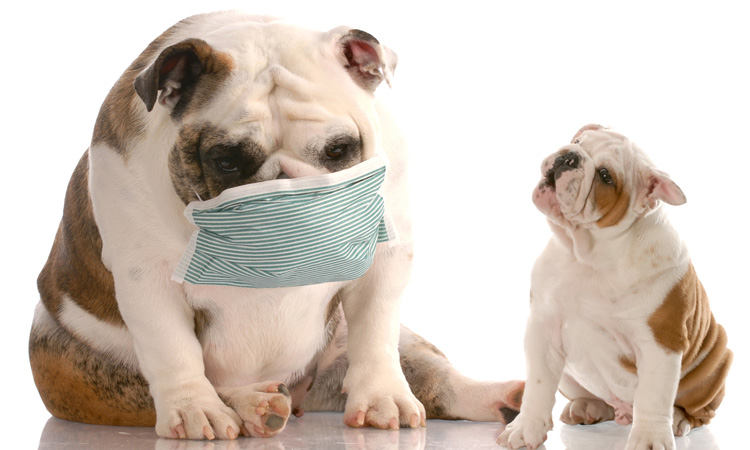

- Dog/Cat
Pet Care Tips for Every Season: An Ultimate Guide
Posted on 01/18/2020

We know that we need to take preventative measures to keep ourselves healthy but what about our furry friends?
Taking good care of our cats and dogs is our top priority as pet owners. However, it can be difficult to protect pets from common harm and illness if you don’t know what to look for. That’s why it’s important to consider every factor that may affect your pet. This includes the two factors that are especially the two that are most often overlooked — your geographical location and the season.
Pets depend on us to meet their nutrition and shelter needs, but they also need us to look out for their health. It’s essential to be educated about what effects the region you live in and the seasons can have on your dogs and cats. If you’ve adopted a set-it-and-forget-it mentality for your pets’ care regimen, it might be worth re-assessing that stance. Here’s everything you need to know about pet care based on location and season in the U.S.
Common Pet Medications & Their Uses
It’s common to help treat adverse seasonal effects in your dogs or cats through the use of medication. Many of these medications are widely available and the illnesses easily cured, it’s important that every pet owner has a basic idea of how and when to use them.
Medicines for Fleas and Ticks
Fleas and ticks are a huge concern for dogs and cats that spend a lot of time outdoors or regularly interact with heavy fauna., underbrush, or forest environments. Ticks and fleas are often found in these areas and can latch onto their fur. These pests can be hard to spot in your pet’s coat. If left untreated, it can cause them to develop health complications such as FAD (Flea Allergy Dermatitis) and Lyme disease.
Flea Allergy Dermatitis is a skin allergy caused by a hypersensitivity to flea’s saliva. It can result in itchy, scabby, pus-filled and irritated skin. Atopica is usually the treatment of choice for both dogs and cats with mild to severe atopic dermatitis. Lyme disease is the most common tick-transmitted disease in dogs.
Although symptoms only seem to manifest in about 10% of affected dogs, they can be debilitating and lead to further complications such as chronic inflammation of the joints. Galliprant and Rimadyl are two of the most popular choices of NSAID (Non Steroidal Anti Inflammatory) when it comes to chronic pain relief for dogs..
Some regions of the United States are more likely to be populated with fleas and ticks. According to the maps at the Center for Disease Control, if you live in the Eastern half of the U.S, your dogs and cats are at a much higher risk of flea bites.
How to Prevent Fleas
There are many ways to prevent fleas from making their home on your pet and causing your dog or cat significant discomfort and stress while putting your household at risk of infestation. Pet owners who want to take a more DIY natural route in flea prevention have many options. Apple cider vinegar and lemons are natural weapons against fleas.
Fleas don’t like acidity. Spraying your pet down with an acidic mixture made with one1 part apple cider vinegar and three parts water or giving your pet a bath in diluted lemon juice, can help to significantly reduce the chance that your pet brings home the pest. Be sure to dilute any acidic mixture that you use on your pets — acidity can exacerbate skin issues and cause burns! If your cat or dog is exposed to the outdoors (even your backyard), these DIY solutions may not be enough to fully eliminate the risk of flea infestations.
Although this danger is more prevalent in the warmer months when insects are more active, it is important to remember that exposure can happen at any time of the year. If your pet is at risk for such bites, you can use flea medication to prevent and treat the adverse effects.
Some of the highest rated monthly topical and oral preventative include Sentinel and Frontline Plus. If you favor a more long-term approach (6 to 8 months of protection), the Seresto Flea Collar is the choice for you.
Medicines for Pet Skin and Coat Conditions
One of the ways that dogs (in particular) deal with stress is to scratch out their coats. Excessive scratching can lead to bruising, bald patches, cuts, and rashes. If this is the case for your pet, you’ll need medication to help relieve the irritant and reduce your pet’s stress.
A topical spray can help provide instant relief or numbing to the affected area., This resolves any scratching; a salve can help heal the scabs or rashes and promote hair regrowth.
Dry weather can exacerbate this condition, so it’s a good idea to keep an eye out for skin issues during the colder months of the year.
Prevent Dry Skin in the Winter
Avoid shampooing your dog in the winter, this strips away the natural oils in their coat that protects them from the cold. If you must wash your pet in the winter months, you’ll need to ensure that you are using a shampoo with moisturizing ingredients such as aloe and oatmeal.
Heartworm Medications
Worms are among the worst parasites for animals to encounter because some untreated worm disease can be fatal. Dogs and cats both are prone to parasitic worms and heartworm disease.
Hookworms, whipworms, tapeworms, and roundworms are all of concern, as these parasites find their way into your pet’s gut and can steal nutrients from them. Heartworm disease is a life-threatening condition in which the worms larvae (Dirofilaria immitis) spread through mosquito bites and enter your pet’s body, grow, and cause irreversible damage to your pet’s organs. However, this disease is preventable!
Your pet should be on a monthly preventative heartworm treatment year-round. Cats and dogs should be checked for heartworms prior to beginning preventative medications, like Heartgard or Sentinel . If your pet is already infected with heartworms, you will need to be prescribed a deworming medication in order to kill the adult worms and prevent lung, liver, kidney or heart failures, which can result in death.
Triflexis is one of the best all-around medications for preventing illnesses caused by parasites in dogs. It prevents fleas and heartworm. Triflexis also treats hookworm, whipworm, roundworm infections, and kills fleas. It’s a once a month tablet that will grant you peace of mind.
Arthritis and Pain Medicines
Older dogs and cats experience the same stiffness and joint pain associated with aging that humans often do! Providing a panacea for these pains is one way to care for pets as they get older. Arthritic and pain medications for pets such as NSAIDs (Non-Steroidal Anti-Inflammatory Drugs) or joint supplements can help to reduce swelling and pain.
Cooler and drier seasons like fall and winter can exacerbate these symptoms. If you have an elderly dog or cat who struggles with arthritic joints try out some of these solutions to help.
Medicines for Allergies
Allergies definitely aren’t just for humans! If you’re noticing that your dog or cat is sneezing or wheezing, you may want to see if they’re breathing in any common allergens. Research whether there’s anything endemic to your area that commonly causes flare-ups of the skin and respiratory systems of household pets. More on that later!
Some allergies may be seasonal. Certain allergens are more prevalent in the spring and summer months when plants begin to grow. Other allergies can be food-related and caused by diet. The symptoms can be similar, so make sure you speak with your veterinarian about seasonal and diet concerns.
Be on the lookout for any skin or coat issues with your pet. Common treatments for chronic seasonal allergies include steroids (Methylprednisolone tablets ), antihistamines (Benadryl) and Apoquel. Your veterinarian will determine the appropriate treatment for your cat or dog.
How to be Proactive About Your Pet’s Health
It’s important to be proactive when it comes to your pet’s health. Small decisions take on a whole new significance when you’re working to ensure that your pet stays healthy.
Being proactive can mean many things, from avoiding pest-filled hiking trails to treating your pet with a lemon juice bath on a monthly basis. Talk to your veterinarian about what you can do at home to ensure that your pet stays healthy for years to come.
What to Consider for Pets in the Northeastern U.S.
The Northeastern United States consists of, roughly, the portion of the U.S. which is bordered at the North by Canada and to the East by the Atlantic sea. A topographically diverse area, it includes colder beaches as well as the wild mountains of Appalachia. If you’re located here, there are several things to consider about how the region may affect your pet.
The Climate of the Northeastern U.S.
While the climate varies, as this region of the U.S. covers ground from Maine to Maryland, the seasons are rather temperate. Rolling winds coming up from the tropics can result in lots of summer storms and humidity along the coast. The winter brings with it Canadian icy snow and sleet. Lots of rain and wind throughout the year characterizes much of the climate of the Northeastern United States.
Harmful Insects in Northeastern U.S.
The paper wasp is indigenous to the Northeastern U.S., as well as several other varieties of wasp whose venom ranges from merely irritating to poisonous. Other harmful insects include Japanese beetles and cabbage worms!
Use of your cat or dog’s flea collars will be helpful when warding some of these insects off. However, others will require your being very protective of your pets’ time in the outdoors. You’ll also need to be wary of mosquitoes in this region, they can carry dangerous parasites and diseases.
How to Protect Pets in the Northeast U.S.
If you live by the coast, be advised that sand is one of your pet’s unsung worst enemies. Eating it can destroy their digestive tracts. Sand may cause rashes and allergies to flare up in your cat or dog. If you live in Appalachia, practice flea and tick prevention on a regular basis—whether your pets are going up into the mountains or not.
Be sure to keep up with your pet’s heartworm preventative treatments, check their coat and skin after outings, and keep them warm during the winter months!
What to Consider for Pets in the Midwest U.S.
The Midwest United States comprises the central section of America. The midwest features a colder and drier climate due to the lack of proximity to water.
The Climate of the Midwest U.S.
The Midwest features a temperate climate—but more of a varied one than, perhaps, you may find in the South. All four seasons are represented in their more extreme forms. Summers get hot and humid in some parts (Kansas, Missouri, Ohio, Illinois) and milder in others (Wisconsin, Minnesota).; The spring and fall last longer than they might in more extreme climates. The winters are cold but—for most of the region—not frigid.
The proximity of the specific state to Canada and the Great Lakes determines how much snow and ice they get. For example, Northern Illinois and Minnesota get more extreme winters than Southern Ohio and Missouri.
Harmful Insects in Midwest U.S.
The Midwest is comprised of many crops that attract regional pests., These pests include soybean aphids, bean leaf beetles, Japanese beetles, and spider mites. The number and type of insects do vary by season: for example, in the summer, the Midwest does get swarmed by mosquitoes, fleas and ticks.
How to Protect Pets in the Midwest U.S.
As summertime does bring mosquitoes in droves in the Midwest U.S., and mosquitoes can be very harmful to pets, you may be looking at skin abrasions and rashes that build-up (especially by the end of the summer!).
Investing in a skin and coat topical spray may provide relief to your cat or dog.They may also condition and moisturize their skin during the long, dry Midwestern summers. Stay on top of your flea, tick and heartworm monthly preventive treatments to ensure year-round protection.
What to Consider for Pets in the South
The South is one of the largest regions of the United States of America! Formally the area bounded by Texas, the Atlantic Ocean, Washington DC and the Gulf of Mexico. The South presents its own considerations for pet owners in the heart of Dixie.
The Climate of the South
As the Southern region of the United States is closest to the Equator, it is generally warmer and more humid feel than the rest of America. However, in the South, you’ll find that there are two distinct subregions that act in two differing ways: The Deep South and the Piedmont area.
The Deep South features states that are south of the Virginias. This subregion spring features cool mornings and warm afternoons. The summer does get very hot—with temperatures routinely breaking triple digits. Fall is a brief stint while the temperatures fall, and winter is generally cool and very wet.
The Piedmont area—which is the line of states roughly from Missouri to Virginia—is a bit less varying in its weather patterns. Spring and summer feature similar warm temperatures and humidity. The mountainous areas get very chilly year-round. In the winter, snow is a rarity, but it can get very cold relative to the Deep South.
Harmful Insects in South
Mosquitoes are definitely a concern in the summer, and ticks and fleas will be found in any of the regions with forests and mountains aplenty. However, the primary harmful ‘insect’ in the South is its population of spiders.
Brown recluses, black widow spiders, and red widow spiders all abound, particularly in the warmer months. Spiders are less likely to attack and bite your pet. However, if your pet eats a poisonous spider, let your vet know! This can have an adverse reaction on your pet’s digestion.
How to Protect Pets in the South
Southern cats and dogs will definitely want to take preventative measures against the sun and heat (pets can overheat just as quickly as humans!). Focus on hydration and protecting their paws on hot surfaces. Foliage is also a concern, as the Deep South has a lot of variance with its flora. Make sure that your pets refrain from eating strange and potentially harmful plants.
Your Pets and the Weather
Extreme weather can be detrimental to your pet’s health, especially if you’re not sure how to keep them safe. If you are located in a region that experiences extreme weather in the winters or summers, you’ll need to have procedures in place for each season.
The summer months may require more frequent grooming to prevent overheating. You may have to ensure that your home is kept warm in the winter for your cat. As a pet owner, it’s important to be educated on the signs of overheating or hypothermia.
What to Consider for Pets in the Western U.S.
The Western United States is the largest region sectioned off in American geography. As a result, it has wildly varying topography and climates. However, there are a few things to keep in mind when trying to effectively ensure your pet’s optimal health.
The Climate of the Western U.S.
For the most part, the Western U.S. is officially classified as a ‘semi-arid’ region, meaning that it doesn’t experience lots of rainfall. However, because of the vastness of the area, this can only be taken as a generalization. There are places nearer the coast that see a considerable amount of rainfall. The majority of the American west does constitute landlocked states that do resemble more a desert than a garden.
Harmful Insects in Western U.S.
While mosquitoes are an issue for all of America, the West is the regional hotspot for Anopheles mosquitoes.— These mosquitoes have bites that can cause you and your pets to get sick.
Africanized Bees, Puss Caterpillars, and Arizona Bark Scorpions, and a variety of snakes are also harmful insects in the West. If you plan on taking your pet outside for an extended period of time — to go hiking, for example, or for a camping trip —ensure that they are protected.
How to Protect Pets in the Western U.S.
Heat and hydration will be two of your largest concerns in most of the Western U.S. If your pet has fairer hair, you will need to ensure that your pet stays out of the sun. All pets will need access to water and shade often, particularly in the summer months. However, due to the large, toxic bugs that can be found over large swaths of the region, you will also definitely want to invest in bug spray or collars for your cat or dog if you live in the Western U.S.
How to Protect Your Pet From Illness
Ultimately, you can’t protect your pet from everything—but you can prevent most common ailments by simply being proactive. Your pets should always be on monthly oral and/or topical treatments for the “big three” aka Fleas, Ticks, and Heartworms. These are the most common health threats to dogs and cats and can be prevented with proper care and routine vet visits.
The Importance of Pet Insurance
You likely pay for yourselves and the human members of your family to be insured and you should consider doing the same for your pets. If you sign your pets up for insurance when they are young and healthy, the monthly investment will likely be inexpensive. If you sign up later, when your pet has an age-related illness (or if something traumatic happens when they are younger) you may end up paying more.
However, pet insurance will help you save money on medications and procedures if they become necessary. If you plan on caring for your pet for more than just a few years, pet insurance is likely worth it. Talk to your veterinarian about what options you have at your next scheduled visit.
The Secret to Finding Discount Pet Medicine
Next time your veterinarian mentions a medication, take note of the name and do some shopping around.
You don’t have to buy the medicine at the vet’s office or at the local pet store; In fact, you can often find better quality products for much less money by filling your pet prescriptions online. Sometimes this can take some digging, but your investment will go further, enabling you to keep your pets and wallet happy and healthy for longer.
Take care to ensure that you’re using a well-rated and dependable distributor for your pet meds online. The last thing you want is a strange off-brand medicine that could potentially harm your pet.
Other tips for those who wish to buy pet medicine online include:
- If you live in the USA, finding a United States distributor is a good idea. US distributors are overseen by federal regulatory agencies. This can be a good indicator of quality (or at least, safe and tested) products.
- If you’re buying from an Internet pharmacy, make sure that it is licensed by the NABP National Association of Boards of Pharmacy. It should have such a license from the state in which it is based if it’s a nationwide service.
- Vet-VIPPS, the Veterinary Verified Internet Pharmacy Sites association, has a listing of approved pharmacies. If a distributor is on their list, then that distributor is complying with all federal and regional recommendations for safety.
Final Thoughts
If you have a furry best friend, then you’re already familiar with the time and money it takes to make sure that they remain healthy. Go one step further by doing the research to ensure that your care matches up with the regional concerns and effects your environment may be having on your pets.
If your pet gets sick, you need to know where to go to get safe and effective medication fast without breaking the bank. That’s where OnlyVetMeds.com comes in.
We know that your pets are family and their health is a priority. That’s why at OnlyVetMeds.com we supply only safe (we’re a licensed and accredited online dot pharmacy!) and discount pet meds, so you can focus on what’s important — your pet’s health. Skip the high cost of pet meds and get the most out of your online pet pharmacy by shopping with us.

 Flea and Tick
Flea and Tick Heartworm
Heartworm Skin & Coat
Skin & Coat Medications
Medications Rx Food
Rx Food Arthritis & Pain
Arthritis & Pain Vitamins & Supplements
Vitamins & Supplements Electrolytes
Electrolytes Wormers/Deworming
Wormers/Deworming Dental Care
Dental Care Flea and Tick
Flea and Tick Heartworm
Heartworm Skin & Coat
Skin & Coat Medications
Medications Rx Food
Rx Food Arthritis & Pain
Arthritis & Pain Vitamins & Supplements
Vitamins & Supplements Electrolytes
Electrolytes Wormers/Deworming
Wormers/Deworming Dental Care
Dental Care



